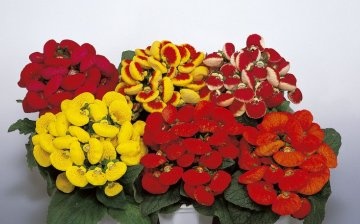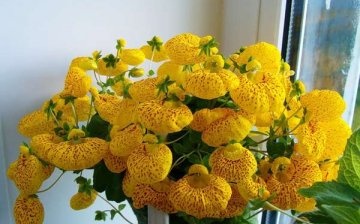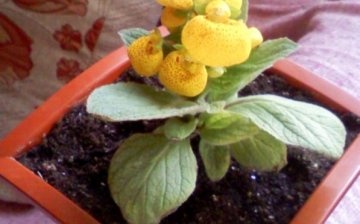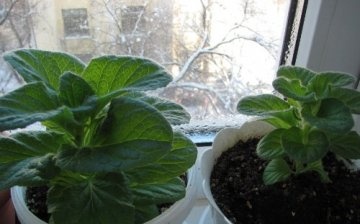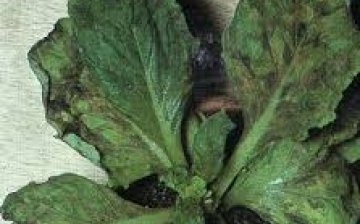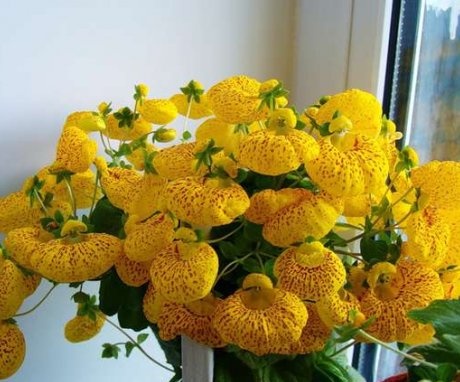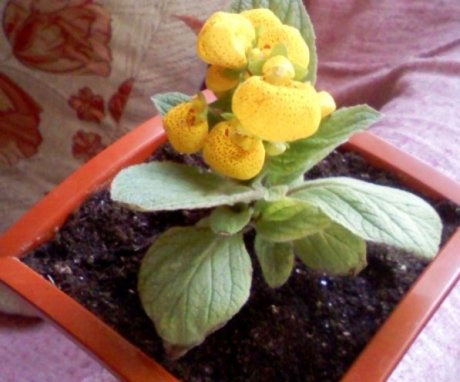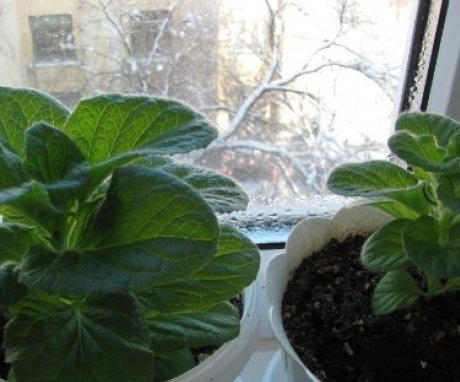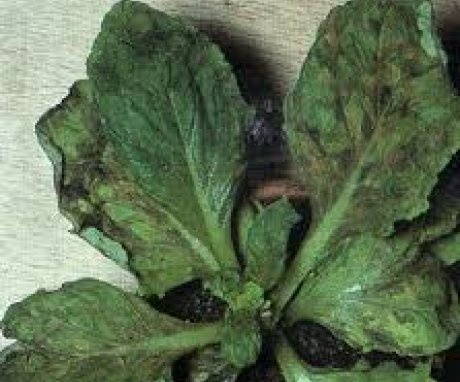Calceolaria flower: how to properly care for and plant it
There are plants, the appearance of which is similar to birds, fruits, objects of inanimate nature. This is often reflected in the name of the culture. So, for example, happened with the bright yellow calceolaria, whose name is translated from Latin as "slipper". Fluffy and airy, like balloons, the bags in shape really resemble wooden shoes from the illustrations for Andersen's fairy tales.
Content:
Types of calceolaria
The plant has become popular both in the design of the garden plot - it is especially often used to create a border or in the composition of an alpine slide - and in the design of a balcony or as a room decoration.
It's believed that calceolaria has a beneficial effect at work of the cardiovascular system. The plant also charges with positive energy, attracting love, which is not surprising: the cheerful palette of yellow, orange, red and white shades of shoes adjusts only to positive emotions. Dark touches and dots create a whimsical pattern and complement the fun look of a lively shoe collection.
There are several types of flower, differing mainly in the size of the plant and the color of the inflorescences.
Here are some of them:
- Miniature Darwin's calceolaria. This species grows up to 12 cm. The yellow pigment of the flowers is diluted with chestnut spots.
- Calceolaria is tender. The flower is slightly lower, its height is 6-8 cm. The petals have a golden yellow hue. Red strokes are located closer to the center.
- Calceolaria is wrinkled or whole-leaved. A feature of the species is the abundant flowering of the culture, as well as the large size of the bush. The flower can grow up to one and a half meters. Inflorescences of a red hue, smoothly turning into yellow. It is a perennial species of calceolaria. Differs in increased stability. In warm regions, it is possible to grow crops in the open field. In temperate climates, the flower is planted in a pot in order to rearrange it indoors with the onset of the first frost.
- Multi-root calceolaria. The main feature that characterizes the flower is the liana-like, creeping structure of the stem. The multi-root type is also a perennial plant adapted for growing both in the garden and in indoor conditions. The color of the inflorescences is yellow.
- Calceolaria is thin. Differs in medium size (35-40 cm), lemon shade of petals. A versatile species in terms of growing conditions.
- Hybrid calceolaria... The most popular type of plant used for balcony and indoor cultivation. Combines a large number of different varieties. It got its distribution among florists due to the variety of shades of flowers. There are burgundy, snow-white, orange varieties. Many of them are characterized by variegation. The leaves are fluffy, pale green. They give the plant additional decorative effect.
It is curious that varieties with tiger-colored shoes are much more capricious than monochromatic relatives.
So, when two-colored speckled species are moved to unfavorable conditions, for example, a warm room, they lose their original colors and produce monophonic inflorescences.
Care rules
If the flower is planned to be placed indoors, then the window sills facing north will be the ideal place.
Calceolaria likes cool temperatures, moderate light and drafts. In a hot and stuffy room, the buds and flowers of the plant fall off. The bush develops poorly in dry air.
In the garden, flowers are planted on the site, out of direct sunlight and with sufficient air circulation. Therefore, the bushes are usually placed in an ensemble with other crops, protecting fragile shoes from rays.
One of the popular types of outdoor calceolaria is the wrinkled type of crop.
For 150 years, this type of plant has been grown in flower beds by flower lovers. So, in England, at the court of the legendary Queen Victoria, yellow-speckled shoes, very reminiscent of a magnificent orchid in appearance, have earned the fame of favorites. Flowers were bred mainly by cuttings, keeping them in winter gardens and greenhouses during the cold season.
The era of favorites quickly ended. They were replaced by varieties of marigolds with large inflorescences and a yellow color similar to calceolaria. Alas, capricious shoes are inferior both in ease of care and in breeding: marigolds are easily and quickly bred by seeds.
Watering has no seasonal features:
- Only his moderation is important.
- Due to the structure of the leaf plates and inflorescences, the plant is not recommended to be sprayed at home.
- A sign that a water overdose has occurred is the clarification of flowers and leaves.
- Waterlogging can lead to death.
Perennial types of shoes are rarely transplanted. They are fed with mineral fertilizers monthly.
When the flowering is over, the bush is cut off, and the root is transplanted:
- After pruning, new shoots sprout.
- In late summer, they can be used as cuttings.
- To form a silhouette of a bush diving is practiced.
- You need to pinch the top of the stem, leaving four to six leaves.
- The main purpose of this technique is to ensure the compactness of the plant and to influence the increase in the abundance of flowering.
So, calceolaria cannot be called an unpretentious culture. It requires constant care and compliance with many conditions for good flowering of the plant.
Reproduction methods
Most types of calceolaria are annual... Thus, after flowering, which usually lasts from spring to autumn, the flower dies. But you can try to extend the life cycle of a pretty bush.
To do this, immediately after calceolaria has faded, you should:
- Cut and place the plant in a cold and dark place for about one and a half to two months.
- During this period, the soil must be moistened, but only so much that the substrate does not completely dry out.
- When the flower gives the first shoots, it is rearranged to the light, intensively watering and fertilizing.
However, in the second season, calceolaria loses some of its decorative effect, as the plant weakens, which means that the flowering decreases and the stems stretch out.
Although, enthusiastic flower growers have come up with a way out here too: fresh shoots are cut off, and cuttings made from them are planted anew.
The rooting substrate is chosen lightweight, which contains:
- Peat.
- Sand.
- Sod layer.
- Compost.
It is also recommended to plant the cuttings in expanded clay, and then transfer them to boxes.
So it is possible, albeit not completely, but to restore the flowering level due to the young root system of the bush. It is much easier and more effective to dilute calceolaria with seeds, although the process will take about six months.
Propagation by seeds:
- They are sown in late spring.
- For sowing, you will need soil, in which the sod layer predominates and the peat part is added.
- It is recommended to mix the seeds with talcum powder before spreading them over the soil surface.
- This is done due to the tiny size of the planting material.
- They should not be dripped in, but only watered and covered with a protective film or other suitable means.
- When the first pairs of leaves appear, the shoots must be dived.
- For seedlings, the conditions for the presence of shade and coolness must be observed. The best option is a cold greenhouse.
- Then the plant is transplanted into flowerpots or pots.
- The soil should contain leaf, turf and peat parts.
- When the bush takes root well, it is planted in a permanent place.
- You will need to add compost and sand to the soil, and place the pots with the plant in open areas that are sufficiently well ventilated.
Obviously, the easiest way to get showy shoes is to buy an already flowering plant at a specialty store. This applies primarily to annual flower species.
Features of pest and disease control
Capricious plants, as often happens with hybrid species, susceptible to many diseases and weakly resist harmful insects and beetles. Let's list the most common ones.
White rot comes first:
- The defeat is caused by a fungus.
In the lower part of the stem and on the roots, dark spots appear, which have eaten into the plant tissue.
- The spots are rapidly increasing in size. They have a white mycelium with a gray tint. The stems gradually dry out.
- The danger of this type of fungus is that by infecting the root system, it continues to develop and remains in the soil for a long time. As a rule, illiterate care and non-observance of conditions of detention leads to the appearance of the disease.
- In order to prevent white rot, the planting substrate is disinfected, further providing good drainage and aeration of the soil. Dry areas are cut off. The plant is saved with preparations of the fungicidal group.
Of the insects that appear on shoes, the most common are various types of scale insects.
- Dark brown or yellow traces form on the leaves where the eggs are laid. The parasites pump out the juice from the cells. Thus, the leaves curl and fall off. Flower development stops and after a short time the calceolaria dies.
- It is quite difficult and time-consuming to drive out pests. You can try to get rid of them with a solution of alcohol containing soap.
A plant sensitivity test is preliminarily carried out on one leaf.
Of the stronger and more effective drugs, Actellic or Phosbecid are used. If you are not afraid of the difficulties of breeding and caring for calceolaria, then welcome to the club of lovers of an unusual and elegant plant. Having received the necessary skills, taking care of a flower will become a pleasant experience, which will generously pay off with amazing shoes, effectively overgrown on the balcony, windowsill or garden bed.
More information can be found in the video.



